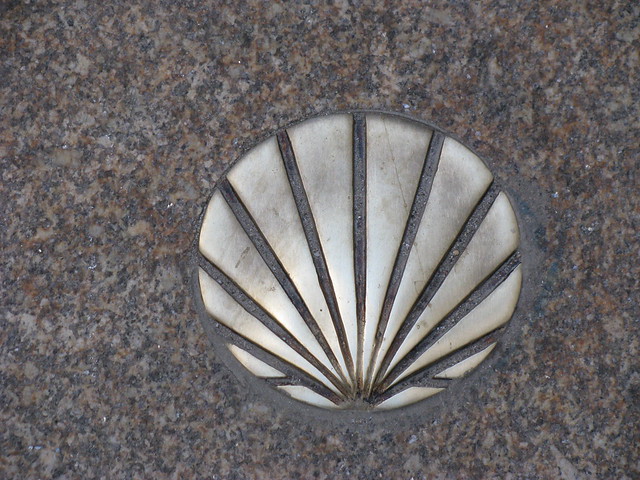Jeff Ballentine and Todd Schlenker spent the month of July, 2011, in Spain. We spent a few nights in Madrid on the front end of the trip and a few nights on the back end, visiting friends, museums and old haunts from 30 years ago, when I studied in Madrid as a college student. During the three weeks in the middle, July 10-29, we did a summer course for Spanish Teachers at the University of Deusto in Bilbao, in the northern Basque country. Our classes met every week day from 9 a.m. to 1:00 p.m. Our three professors were experts in the Spanish language, history, culture and methods of teaching. We learned and shared ideas for teaching Spanish at all levels. Our excursions took us to Pamplona for the running of the bulls and to several other regional attractions like Santillana del Mar, San Sebastian, San Millan de la Cogolla, Santander and Guernica. Our Spanish improved tremendously, and we even learned some of the Basque language, known as "Euskera." Being students helped us recharge our batteries and gave us new insights into the old and new dynamics that make Spain the country it is today. We need to thank the USM Faculty Grant Committee for giving us the opportunity to study in Spain this summer. Fifteen other teachers from across the US and Canada paid their own way because of the value these summer courses offer. They were impressed that USM had the vision and resources to invest in its teachers in this way. So again, MUCHAS GRACIAS, USM.
The Spanish Embassy in the US and Canada invite teachers every summer to study in Spain at a variety of Spanish Universities throughout the country. The AATSP works in conjunction with the Spanish Embassy to aid teachers in making the proper connections. To learn more visit: http://www.aatsp.org/ and , or click on "cursos de verano" at http://www.educacion.gob.es/exterior/usa/es/home/index.shtml.




 A very traditional Spanish game is called the hankerchief game. Someone holds the "pañuelo" between two evenly divided teams. The holder calls out a number and the numbered person on each side has to respond quickly, run and grab the "pañuelo" and run back to their side before being tagged. We saw this being played on the beach, and the teenagers were having a blast. There is an endless number of variations on this game, and Begoña uses it with relative clauses that call for subjunctive. Another game to use as a warm up is called "a mi derecha," where a student who has a vacant desk to his/her right uses a relative clause and subjunctive to see who stands up and sits in that empty chair. The new student who has an empty chair on the right does the same until everyone has gone. Example: I am looking for someone who has a birthday in June. This requires subjunctive in Spanish, and if it's your birthday month you get up and sit on the speaker's right. We can all adapt this game in some form. Begoña pushes forward in the book, and tomorrow we get to do more subjunctive. Yippee!
A very traditional Spanish game is called the hankerchief game. Someone holds the "pañuelo" between two evenly divided teams. The holder calls out a number and the numbered person on each side has to respond quickly, run and grab the "pañuelo" and run back to their side before being tagged. We saw this being played on the beach, and the teenagers were having a blast. There is an endless number of variations on this game, and Begoña uses it with relative clauses that call for subjunctive. Another game to use as a warm up is called "a mi derecha," where a student who has a vacant desk to his/her right uses a relative clause and subjunctive to see who stands up and sits in that empty chair. The new student who has an empty chair on the right does the same until everyone has gone. Example: I am looking for someone who has a birthday in June. This requires subjunctive in Spanish, and if it's your birthday month you get up and sit on the speaker's right. We can all adapt this game in some form. Begoña pushes forward in the book, and tomorrow we get to do more subjunctive. Yippee!  Spaniards have a rich literary tradition growing out of newspapers, and therefore, the comics have perhaps played a bigger role than in American culture. Just like Peanuts was a comic before it debuted on t.v. so too have many Spanish comics evolved. He gives us some good tips on how to use them in class, and we learn that the bubbles that hold the speech are called "bocadillos." I asked what we called them in English, and "bubbles" seems right, but please comment if you know better. Maddy suggested we check out
Spaniards have a rich literary tradition growing out of newspapers, and therefore, the comics have perhaps played a bigger role than in American culture. Just like Peanuts was a comic before it debuted on t.v. so too have many Spanish comics evolved. He gives us some good tips on how to use them in class, and we learn that the bubbles that hold the speech are called "bocadillos." I asked what we called them in English, and "bubbles" seems right, but please comment if you know better. Maddy suggested we check out  King Juan Carlos I and Queen Sofia
King Juan Carlos I and Queen Sofia






